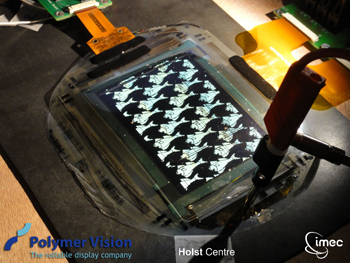A new research program has been initiated by imec and Holst Centre, based on advanced flexible OLED displays. This has been developed on the foundation laid by research partners in flexible OLED lighting, organic and oxide transistors.
 Flexible OLED display developed in close collaboration with Polymer Vision, one of the industrial partners in the shared programs at Holst Centre and imec.
Flexible OLED display developed in close collaboration with Polymer Vision, one of the industrial partners in the shared programs at Holst Centre and imec.
This new program is intended to develop an economically scalable method for an increased level of flexible active-matrix OLED display production. Several challenges will be met through this combined program as the value chain partners are being demanded of low power consumption, high resolution, outdoor readability, large area, flexibility and compactness.
Currently, the innovative OLED displays are compact and are being used with novel applications including tablet PCs and smart phones. One of the significant features of OLED is that unlike conventional LCDs, the OLED pixels emit only on being activated, achieving a more intense black. Other features of OLEDs include time lag elimination, less power consumption based on usage profile, accelerated response time, simpler design with only a few components and improved viewing angle and contrast compared to conventional LCDs.
The new program is focused on high-resolution and flexible OLED displays and certain approaches including printed, high-efficiency OLEDs, an adaptable encapsulation film and TFT backplane. Development of new processes and materials facilitating lower power, cheaper production, higher quality, with increased flexibility and strength will be initiated. As the amount of PPI or the refresh rates has been influenced by growing display area, the design of the TFT backplane matrix, drivers, and pixel circuits will be reviewed. The program further anticipates developing new manufacturing equipments including tools for integrated roll-to-roll manufacturing and fine patterning equipment for backplanes.